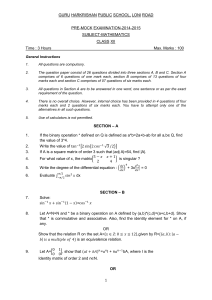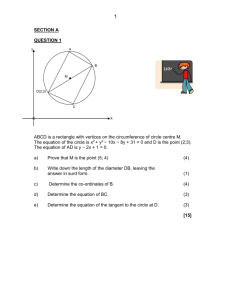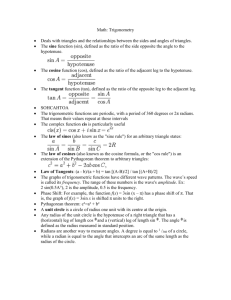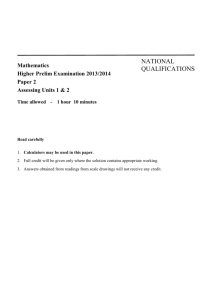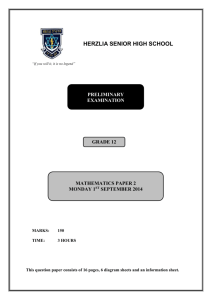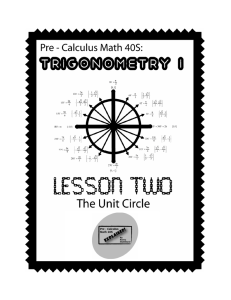Paper 2
advertisement
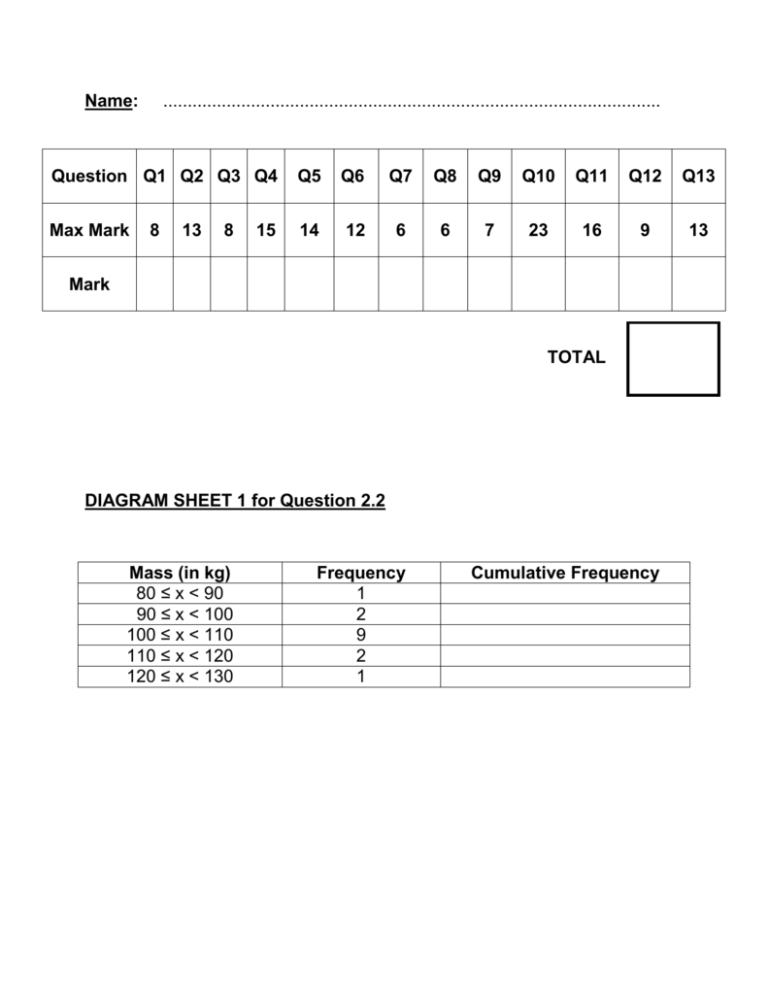
Name: ...................................................................................................... Question Q1 Q2 Q3 Q4 Q5 Q6 Q7 Q8 Q9 Q10 Q11 Q12 Q13 Max Mark 14 12 6 6 7 23 16 9 13 8 13 8 15 Mark TOTAL DIAGRAM SHEET 1 for Question 2.2 Mass (in kg) 80 ≤ x < 90 90 ≤ x < 100 100 ≤ x < 110 110 ≤ x < 120 120 ≤ x < 130 Frequency 1 2 9 2 1 Cumulative Frequency DIAGRAM SHEET 2 for Question 2.3 Mass in kg DIAGRAM SHEET 3 for Question 3.1 English Marks TV Hours DIAGRAM SHEET 4 for Question 9.1 DIAGRAM SHEET 5 for Question 13.5 RONDEBOSCH BOYS’ HIGH SCHOOL Mathematics Grade 12 Tuesday 25th September 2012 Set by: R Harmuth 3 Hours ; 150 Marks Moderated by: D Geldenhuys PAPER TWO INSTRUCTIONS 1. Calculators can be used, unless otherwise stated, with answers corrected to two decimal places. 2. All necessary working MUST be shown. 3. When necessary, leave answers with positive exponents. 4. Number your answers as the questions are numbered. 5. Untidy work will be penalised. 6. Only blue and black pens may be used. 7. Sketches may be done in pencil. 8. This exam contains thirteen questions. Question One The table below gives a breakdown of the Western Union Currie Cup Rugby log standings for the top 8 teams at the end of the 2001 season in Wales: TEAM Harlequins Wasps Sparrows Robins Wonders Sharks Dolphins Golden Men POINTS 56 52 50 50 44 40 32 24 1.1 Determine the median (number of points scored). (2) 1.2 Determine the lower AND the upper quartile. (2) 1.3 Draw a box and whisker to represent the points scored. (3) 1.4 Use your box and whisker to comment on the spread of the points scored by the teams. (1) [8] Question Two The masses (in kg) of the Springbok Rugby Team to play New Zealand in September are given below: 95 105 100 118 109 126 107 82 108 116 109 98 100 105 2.1 Calculate the mean mass of the Springbok team. 2.2 Complete the following table on DIAGRAM SHEET 1. Mass (in kg) 80 ≤ x < 90 90 ≤ x < 100 100 ≤ x < 110 110 ≤ x < 120 120 ≤ x < 130 Frequency 1 2 9 2 1 102 (2) Cumulative Frequency (2) 2.3 2.4 Draw an ogive (cumulative frequency curve) of the above information on the grid provided on DIAGRAM SHEET 2. (4) Calculate the percentage of the team who have masses within one standard deviation of the mean. Show ALL calculations. (5) [13] Question Three A group of 12 learners was randomly selected from a class. The marks scored in a standardised English test (out of 100 marks) and the average number of hours they spent playing TV games (on a computer) per week was recorded. English Marks 80 65 50 30 70 60 85 45 45 90 35 75 TV hours 10 20 35 45 15 25 10 37 23 5 40 18 3.1 Represent this data as a scatter plot on the grid provided on DIAGRAM SHEET 3. (4) 3.2 Draw a line of best fit for your scatter plot. (1) 3.3 What conclusion can you make about the learners’ marks and the average number of hours spent on TV games? (1) Another learner from the class spends 30 hours playing TV games. Predict his English mark. (2) 3.4 [8] Question Four In the diagram below, ∆ PQR with vertices P(3 ; 1), Q( 8 ; 2) and R(2 ; 3) is given: 4.1 Calculate the length of QR, leaving your answer in surd form. (2) 4.2 Determine the co-ordinates of M, the mid-point of QR. (2) 4.3 Determine the equation of the line parallel to PR, passing through M. (4) 4.4 If PQTR is a parallelogram find the co-ordinates of T. (2) 4.5 Calculate PRQ. (5) [15] Question Five 5.1 5.2 The equation of a circle is given as x 2 2 x y 2 6 y 30 0 5.1.1 Prove that the point P( 1 ; 9) lies on the circumference of the given circle. (2) 5.1.2 Determine an equation of the tangent to the circle at the point P( 1 ; 9). (7) Calculate the length of the tangent DE, drawn from the point D(2 ; 6) to the circle with equation ( x 4 )2 ( y 1 )2 12 . E is a point on the circumference of the circle. (5) [14] Question Six The circle with centre C and equation ( x 3 )2 ( y 4 )2 34 is drawn below. A is a y-intercept of the circle. 6.1 Determine the value of y at A. 6.2 The circle is enlarged by a scale factor of 2½ about the origin. Write down the equation of the new circle in the form ( x a )2 ( y b )2 r 2 . 6.3 (4) (3) In addition to the given circle with centre C and equation ( x 3 )2 ( y 4 )2 34 , another circle with centre P and equation ( x 9 )2 ( y 10 )2 49 is now given. 6.3.1 Calculate the distance between C and P. (2) 6.3.2 Do these two circles cut once, twice, or not at all? Justify your answer. (3) [12] Question Seven The point A( 3 ; y ) is rotated about the origin through an angle of 120° in 1 an anti clockwise direction to give the point B( x ; ). 2 Calculate the values of x and y . [6] Question Eight Consider the point P(14 ; 5). The point is reflected about the y -axis to PꞋ. 8.1 Write down the co-ordinates of PꞋ. (1) 8.2 An alternative transformation from P to PꞋ is a rotation about the origin through an angle of °, where < 180°. Calculate . (5) [6] Question Nine In the diagram below, ∆ MNR is drawn with vertices M(6 ; 2), N( 6 ; 8) and R(1 ; 6). ∆ MNR is now enlarged by a factor of 2 to ∆ MꞋNꞋRꞋ. 9.1 Draw ∆ MꞋNꞋRꞋ on the grid provided on DIAGRAM SHEET 4. 9.2 Write down the values of: 9.2.1 9.2.2 M N MN Area of Δ M N R Area of Δ MNR (3) (2) (2) [7] Question Ten 10.1 10.2 SHOW ALL NECESSARY STEPS IN THIS QUESTION If sin 24 m , and cos 35 n , determine the following in terms of m and/or n : 10.1.1 tan 66 (3) 10.1.2 sin 70 (3) 10.1.3 cos 114 (2) 10.1.4 sin 59 (3) Without using a calculator, find the value of A if: 10.2.1 A cos 220 tan 140 tan 30 sin 630 cos 50 (8) 10.2.2 A ( 2 cos 75 1)( 2 cos 75 1 ) (4) [23] Question Eleven 11.1 Given: cos 2x 5 cos x sin 2 x Determine the general solution. 11.2 (8) tan 2 x 1 Consider the expression tan x 11.2.1 11.2.2 For which values of x , x [0° ; 180], will this expression be undefined? Prove that tan 2 x 1 2 tan x sin 2 x (3) (5) [16] Question Twelve A person standing at point P looks up to the top, Q, of a double- storey house. P is 17m from the foot of the house. The angle of elevation of Q from P is 33°. He turns around and walks in the opposite direction from the house at an inclination of 8° for a distance of 12m to a point M. Let PQM . Q M 12m 33° F 17m 8° P 12.1 Calculate PQ. (2) 12.2 Calculate the length of QM (4) 12.3 Hence, calculate . (3) [9] Question Thirteen The graph of f ( x ) 2 cos x for 180 x 180 is drawn below : 13.1 Write down the period of f . (1) 13.2 For which values of x is f ( x ) 0 ? (2) 13.3 Write down the x - intercepts of g ( x ) if g( x ) f ( x 60 ) . (2) 13.4 Write down the amplitude of h( x ) if h( x ) 13.5 Draw k ( x ) sin( x 45 ) ON DIAGRAM SHEET 5 PROVIDED showing intercepts with axes and turning points. (4) 13.6 For which values of x is k (x) 0 and f ( x ) 0 ? f (2x ) 4 (2) (2) [13]
